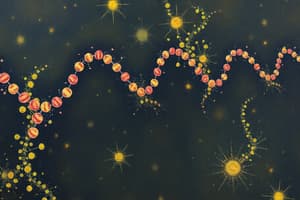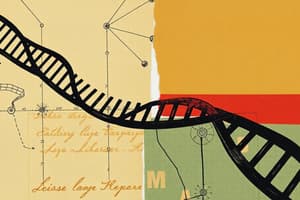Podcast
Questions and Answers
Which enzyme is responsible for unzipping the DNA helix by breaking the hydrogen bonds between nucleotides?
Which enzyme is responsible for unzipping the DNA helix by breaking the hydrogen bonds between nucleotides?
- Primase
- DNA polymerase
- Ligase
- Helicase (correct)
Single strand binding proteins prevent DNA strands from rejoining after they have been separated by helicase.
Single strand binding proteins prevent DNA strands from rejoining after they have been separated by helicase.
True (A)
What is the function of topoisomerase in DNA replication?
What is the function of topoisomerase in DNA replication?
relieves tension/supercoiling
_______ synthesizes a short RNA sequence to act as a starting point for DNA polymerase.
_______ synthesizes a short RNA sequence to act as a starting point for DNA polymerase.
Which enzyme primarily adds bases to the new DNA chain and also performs proofreading during replication?
Which enzyme primarily adds bases to the new DNA chain and also performs proofreading during replication?
DNA polymerase I is responsible for adding the majority of new nucleotides to the growing DNA strand.
DNA polymerase I is responsible for adding the majority of new nucleotides to the growing DNA strand.
What is the role of ligase in DNA replication?
What is the role of ligase in DNA replication?
_______ are synthesized on the lagging strand during DNA replication.
_______ are synthesized on the lagging strand during DNA replication.
Which of the following describes the function of DNA polymerase I (Pol I)?
Which of the following describes the function of DNA polymerase I (Pol I)?
DNA Polymerase can add new nucleotides at both the 3' and 5' ends of an existing nucleotide strand.
DNA Polymerase can add new nucleotides at both the 3' and 5' ends of an existing nucleotide strand.
What is the function of telomerase?
What is the function of telomerase?
_______ are specialized structures at the ends of eukaryotic chromosomes.
_______ are specialized structures at the ends of eukaryotic chromosomes.
Which of the following is NOT a function of telomeres?
Which of the following is NOT a function of telomeres?
Eukaryotic chromosomes are typically circular.
Eukaryotic chromosomes are typically circular.
What is the term for loosely packed chromatin?
What is the term for loosely packed chromatin?
Highly condensed regions of chromatin are called _______.
Highly condensed regions of chromatin are called _______.
Which type of mutation arises from errors in DNA replication?
Which type of mutation arises from errors in DNA replication?
Mutations always result in a nonfunctional end product.
Mutations always result in a nonfunctional end product.
What is the cause of thymine dimers?
What is the cause of thymine dimers?
Which repair mechanism uses light energy to correct thymine dimers?
Which repair mechanism uses light energy to correct thymine dimers?
Flashcards
Helicase
Helicase
Unwinds DNA double helix by breaking hydrogen bonds between nucleotides.
Single Strand Binding Proteins (SSBP)
Single Strand Binding Proteins (SSBP)
Prevents DNA strands from rejoining after being separated by Helicase.
Topoisomerase
Topoisomerase
Relieves tension in DNA by cutting, unwinding, and rejoining strands.
Primase
Primase
Signup and view all the flashcards
DNA Polymerase III
DNA Polymerase III
Signup and view all the flashcards
DNA Polymerase I
DNA Polymerase I
Signup and view all the flashcards
Ligase
Ligase
Signup and view all the flashcards
RNA Primer
RNA Primer
Signup and view all the flashcards
Okazaki Fragments
Okazaki Fragments
Signup and view all the flashcards
Telomerase
Telomerase
Signup and view all the flashcards
Telomeres
Telomeres
Signup and view all the flashcards
Mutation
Mutation
Signup and view all the flashcards
Spontaneous Mutation
Spontaneous Mutation
Signup and view all the flashcards
Induced Mutation
Induced Mutation
Signup and view all the flashcards
Mismatch Repair
Mismatch Repair
Signup and view all the flashcards
Photorepair
Photorepair
Signup and view all the flashcards
Excision Repair
Excision Repair
Signup and view all the flashcards
Chromatin
Chromatin
Signup and view all the flashcards
Basic Structure of Chromosomes
Basic Structure of Chromosomes
Signup and view all the flashcards
Study Notes
Enzymes Required for Replication
- Helicase unzips the DNA helix by breaking hydrogen bonds between nucleotides.
- Single strand binding proteins (SSBP) keeps strands separated during unzipping.
- Topoisomerase relieves the stress from unzipping by cutting one strand, unwinding, and reconnecting it.
- Primase binds to the origin of replication and synthesizes an RNA primer (5-10 nucleotides) complementary to the template.
- DNA polymerase can only attach nucleotides to existing nucleotides on the 3'-OH end, performing most of the DNA synthesis.
- DNA polymerase can only add a new nucleotide to the 3' end of an existing nucleotide.
- DNA polymerase and primase work together in a complex for priming.
- DNA polymerase epsilon (Pol ɛ) synthesizes the leading strand.
- DNA polymerase delta (Pol 6) synthesizes the lagging strand.
DNA Polymerases
- DNA Polymerase is responsible for most of the DNA replication, creating a polymer of DNA.
- DNA Polymerase replicates bacterial chromosomes at around 500 nucleotides per second.
- In human cells, replication occurs at about 50 nucleotides per second due to extensive proofreading mechanisms.
- E. coli has three DNA polymerases used for DNA synthesis.
- DNA polymerase I (Pol I) removes primers and replaces them with DNA on the lagging strand.
- DNA polymerase II (Pol II) is involved in DNA repair processes.
- DNA polymerase III (Pol III) is the main replication enzyme.
- All three DNA polymerases have 3'-to-5' exonuclease activity for proofreading, allowing removal of nucleotides when errors occur.
- DNA Pol I has 5'-to-3' exonuclease activity for removing RNA primers.
DNA Strands and Fragments
- Leading strand is synthesized continuously, moving toward the replication fork and adding to the 3' end.
- Lagging strand replicates moving away from the replication fork, forming Okazaki fragments.
- Each Okazaki fragment is made with a primase adding a primer, followed by DNA Polymerase III adding the DNA nucleotides.
- Primers are removed and refilled with DNA nucleotides by DNA Pol 1, and the backbone is joined by DNA ligase.
Chromosomes and DNA Structure
- A chromosome consists of a DNA molecule packed together with proteins.
- Bacterial chromosome is a double-stranded, circular DNA molecule with a small amount of protein.
- Eukaryotic chromosomes have linear DNA molecules associated with a large amount of protein.
- In bacteria, the DNA is "supercoiled" in a region called the nucleoid.
- Chromatin, a complex of DNA and protein, is in the nucleus of eukaryotic cells and fits through multilevel packing.
- During interphase, chromatin is organized into a 10-nm fiber, compacted into a 30-nm fiber through folding and looping.
- During interphase, chromosomes still occupy specific restricted regions in the nucleus.
Chromatin Packing and Organization
- Most chromatin is loosely packed during interphase and condenses prior to mitosis.
- Loosely packed chromatin is called euchromatin.
- During interphase, centromeres and telomeres are highly condensed into heterochromatin.
- Dense packing of heterochromatin makes it difficult for the cell to express genetic information.
- Histones can undergo chemical modifications that result in changes in chromatin organization.
Telomeres and Telomerase
- Linear chromosomes cannot replace the last primer removed from the 3' end of the lagging strand, leading to shortening with each division.
- Telomerase is an enzyme that synthesizes telomere repeat sequences at the ends of the strands.
- Telomerase uses an internal RNA template (not DNA itself) to do this.
- Telomeres are specialized structures at the ends of eukaryotic chromosomes, composed of specific repeat sequences.
- Telomeres protect chromosome ends from nucleases and maintain the integrity of linear chromosomes.
- Telomeres are not made by the replication complex.
- Their enzymes are similar to bacterial ones.
Telomerase Regulation and Function
- Telomerase activity is high in early development/childhood but low in most somatic adult cells.
- Exceptions to this include cells that must continue dividing, like lymphocytes.
- Telomerase plays a role in senescence (aging).
- Mice lacking telomerase activity had nonviable offspring after six generations.
- Telomerase contributes to cancer; cancer cells activate telomerase to maintain telomere length.
Mutations and Causes
- DNA damage occurs constantly due to random errors during replication, which is why DNA polymerases have proofreading mechanisms.
- External agents, like radiation and chemicals (mutagens), also cause mutations.
- Mutations are changes in the nucleotide base sequence of a genome.
- Mutations are rare and usually result in a nonfunctional gene product, but sometimes improve an organism's ability to survive.
- Genetic change is the driving force of evolution.
- Mutation can be spontaneous: a random change in the DNA arising from replication errors, or induced: resulting from exposure to mutagens.
- Physical or chemical agents disrupt DNA and are also known as carcinogens.
- Radiation such as UV light and X-rays can cause mutations.
Radiation-Induced Mutations
- Ionizing radiation (X-ray/gamma ray) causes electrons to excite, leading to covalent bond breakage of the sugar-phosphate backbone of DNA.
- Nonionizing radiation (UV) causes pyrimidine dimers (covalent bonding), warping the DNA shape.
Chemical Mutagens
- Nitrous acid is a chemical mutagen.
- Nucleotide analogs, which appear like normal nucleotides, can be erroneously substituted for nucleotides during replication.
- Nucleotide analogs can be useful as antiviral or anticancer drugs.
DNA Repair Mechanisms
- Mismatch repair removes incorrect bases and replaces them using the template strand as a guide.
- In E. coli, mismatch repair distinguishes new and old strands by looking at methylation; the new strand lacks methylation on certain sequences.
- UV light can cause thymine dimers, which are repaired by photoactivation/light repair through photolyase.
- The cell absorbs energy in the visible range to cut the thymine dimer.
- Excision repair is a nonspecific repair mechanism where damaged areas are recognized and removed by nucleases.
- The remaining gap is filled by DNA polymerase I and ligase.
Studying That Suits You
Use AI to generate personalized quizzes and flashcards to suit your learning preferences.




